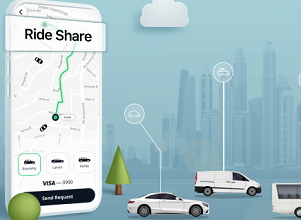Future of mobility and personal transportation
Aloke Palsikar
Sr. Vice President & Global Head of the Manufacturing Vertical
Tech Mahindra

In the early 20th century, Henry Ford said, “Any customer can have a car painted any color that he wants so long as it is black.” Not only did he limit the choice of color, but also the choice of model. Ford wanted to produce only the Model T. His goal was to expand car ownership. To do that, he needed to make the car both affordable and reliable. And he did this by limiting variation in the production of cars. In 1908 his 1,900 workers produced over 6,000 cars. In 1911 his 4,100 workers pro- duced almost 35,000 cars. By nearly tripling productivity, Henry Ford opened car ownership to the working class. His vision was to literally put every American household on wheels.
Almost a century after the Model T, the world continues to display a voracious appetite for the automobile—as an emblem of social status, an icon of blazing independence. Smart, sleek, elegant cars of today combine technology, luxury and class and that has fuelled this insatiable demand.
According to Statista, the world is likely to hit 100 million cars in 2017 [1]. That’s a lot of cars. But here’s an interesting statistic – the utilization rate of automobiles in the U.S. is about 5% [2]. So a hundred years later, when Sherly Connelly, resident futurist at Ford Motor Co says, why buy the car when you can rent it, borrow it, loan it, lease it? [3]; she’s echoing the sentiments of many young consumers who are perfectly comfortable sharing or leasing some- thing, unlike earlier generations who had a mental roadblock towards buying something second hand, renting or borrowing it. Owning a car is almost passé. Automobile finance and low interest rates have ensured that most cars today are financed through attractive leasing and buyback schemes.
Globally we are moving towards a “Shared Economy”. The race is to share resources as opposed to owning them. So you don’t pay for the car. You pay for the usage or the miles. It’s a paradigm shift in the way the world has viewed mobility. Rates of motor-vehicle licensure have already dropped among young Americans. And the obligations and costs of transportation—which is an estimated average 17% of house- hold budgets [4]—are probably added incentives to share rather than buy. And it’s not just the USA, even traditionally car-ownership-driven markets like Italy now boast of car sharing facilities being available in over 15 cities.
Also, according to a Frost and Sullivan study, the average speed at which people travel around the world in cars is about 25 miles per hour [3]. So if you are riding in your car for a couple of hours every day, maybe you don’t just want to stare at the traffic, maybe you have better things to do with your time. You could watch a video or chat with friends or family or check work mails.
Automotive OEMs are not viewing this new consumer behaviour as a threat, but more as an opportunity to expand the automotive value chain and diversify. They are transforming themselves into service providers who offer integrated mobility solutions. Recent proof of that was when earlier in 2016, General Motors invested $500 million in ridesharing company and Uber competitor Lyft. And GM’s president, Daniel Ammann commented that they think there’s going to be more change in the world of mobility in the next five years than there has been in the last 50.
Before the passing of this generation automobiles will be built with what’s known as Level 4 autonomy—full self-driving artificial intelligence for cars. Autonomy will make it possible for un- manned automobiles (of your choice) to be called, via app, to your location–cleaned and fuelled. The technology that goes into matching the rides to passengers is evolving rapidly, incorporating information about observed behaviours to improve rider experience. Not only will death and major injury from traffic accidents drop drastically, autonomous cars could contribute $1.3 trillion in annual savings to the U.S. economy alone, according to Morgan Stanley [5]. And global savings are in the range of an in- credible $5.6 trillion. Level 4 AV technology, when the vehicle does not require a human driver, offers the promise of enabling transportation for millions on the margins including the disabled, the elderly, the working poor or those too young to drive. The benefits for these groups would include independence, and access to essential services.
2016 is not just the year in which GM invested money in a partnership with the express directive of killing the idea of car ownership. 2016 is also the year where fossil fuels are expected to enter their terminal decline. Earlier in 2015, when Toyota announced their plan to transition to hybrid and fuel cell vehicles by 2050, to radically reduce emissions, it wasn’t exactly a shock. And though Toyota may be sceptical about electric vehicles, because they take too long to recharge, today the bestselling car in Norway is not made by any of the top auto OEMs of the world. It’s the Tesla Model S, the world’s first premium electric sedan. One driver even proved it’s possible to drive all the way from Oslo to Kirkenes (over 1100 miles) at an electricity cost of just NOK 400 (less than $50). But in Norway, the vast majority of the country’s electricity is generated through hydropower. For other countries that generate electricity from coal, it’s possible that electric cars might put more pressure on an already overloaded energy grid.
The next generation of cars will not be isolated pieces of metal moving independently but smart hardware which would be connected with other cars as well as the larger ecosystem – a move which is essential to the concept of “Smart Cities” to manage traffic and road infrastructure intelligently. Technology firms are driving much of the change. These firms are the disrupters, who believe that the system’s key source of value could be in creating and managing the vehicle’s system and commuting experience as well as in mining the data generated. KPMG in their Annual Automotive Survey 2016 [6] commented “Automotive OEMs of today will be the contract manufacturers of technology companies tomorrow.’’ Almost every OEM today has already tied up or is in the process of tying up with small start- ups or large tech players to get a handle on the next gen technology in their automobiles.
Coming to mining the data generated twenty-five gigabytes: that’s how much data a connected car will upload to the cloud every hour. Connected Cars are morphing into mobile data centres. They are creating and using data, while communicating with their environment. This data is about everything – route, speed, the wear and tear on its components, and even road conditions. Vehicles today have multiple microprocessors and dozens of sensors that collect telematics and driver behaviour data, and that data can be analyzed in real-time to ensure the vehicle’s performance, efficiency, and safety. It also provides vital feedback about traffic volume and roadway design. Other
than the safety aspect, there’s also the quality of life component – infotainment and entertainment – passengers can log onto social media, view vehicle info, and connect other apps to their car. But who owns all this data? The ownership is being keenly contested – from OEM to dealers and 3rd parties who are getting into this game. We seem to be in for some exciting days ahead as this contest unfolds but I am sure ultimately it will be the consumer who will still rule as the king and have the last laugh.
As much as the world focuses on Uber and Lyft, electric vehicles, hybrids and autonomous vehicles, these technologies are incremental, not disruptive. The last truly disruptive mass personal transportation technology was the Ford Model T. Ford’s innovation redefined automobile culture and led to the creation of cities, bridges, highways etc. designed for the age of personal transportation that was kick started by the Model T.
A peek ahead into the future– a hundred years from now we may see something none of us could have thought possible except in Sci-Fi movies. The Ehang 184 (or its next gen versions) – a human-sized AAV (autonomous aerial vehicle) might be the next truly disruptive mode of mass personal transportation. This technology introduces three-dimensional transportation that no longer confines us to moving about on an earth-bound grid. With a maximum altitude of 11,000 feet, the Ehang 184 leverages a great deal more space to transport people from point to point.
Also the Ehang 184 makes use of rapidly increasing advances in drone tracking and sensing technologies. Each Ehang 184 is able to use GPS technology to accurately pinpoint its own whereabouts, and to keep track of everything else flying in its periphery. Able to compute, set its optimal flight path, and be flexible enough to adjust in emergencies, the Ehang 184 can become a failsafe personal transportation technology. It is perhaps a vision today but it is a vision of a safe, autonomous quadcopter drone for human point-to- point flight.
Ever since mankind has invented the wheel, the concept of transportation has changed over successive generations. Today we are on the cusp of an- other revolution in mobility and transportation which will undoubtedly build a smarter, greener and safer planet,and take humanity forward in their journey to explore new frontiers.
[1] – Outlook on worldwide light vehicle sales from 2011 to 2020
h1p://www.statista.com/statistics/267128/out- look-on-worldwide-passenger-car-sales/
[2] – Could Self-Driving Cars Spell the End of Ownership?
h1p://www.wsj.com/articles/could-self-driving- cars-spell-the-end-of-ownership-1448986572 [3] – The Future of Car Ownership and Autonomous Driving
h1p://www.cheatsheet.com/automobiles/the-future-of-car-ownership-and-autonomous-driving. html/?a=viewall
[4] – Private car ownership is on the road to becoming a rarity h1p://www.marketwatch.com/story/get-ready- to-share-not-just-the-road-but-the-car-2015-12- 14?link=MW_latest_news
[5] – Autonomous Cars: The Future Is Now h1p://www.morganstanley.com/articles/autonomous-cars-the-future-is-now
[6] – KPMG Global Automotive Executive Survey 2016 h1ps://www.kpmg.com/CZ/cs/industry/Automotive/Documents/KPMG_GAES_2016_locked.pdf

